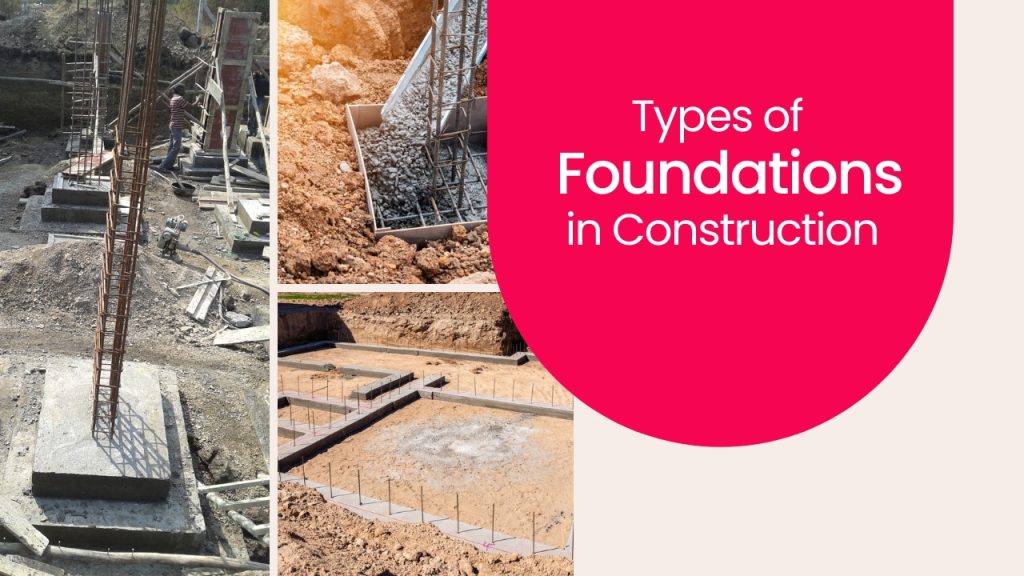Work Hours
Monday to Friday: 7AM - 7PM
Weekend: 10AM - 5PM
Types of Foundations used in Construction Industry

Foundation is an essential part of any structure. Foundation is the base on which the structure is constructed, and the main work of the foundation is to transfer the load of the structure and its components to the ground. The foundation determines a structure’s stability, longevity, and durability. The most common types include shallow, deep, and pile foundations.
In this blog post, we will discuss into the details of a foundation, its importance, and the different types of foundations used in construction.
Advantages of solid & stable Foundations
1) Strength & Stability
Foundations provide stability and strength to the structure. It ensures that the structure can withstand the damages from various natural calamities such as earthquakes, strong winds, tornados, etc.
2) Improves Insulation
Foundations provide good insulation by providing a barrier between the ground and the structure. Due to this, heat loss is prevented and keeps the interior of the structure warm.
3) Increases Longevity
Strong & stable foundation increases the longevity of the structure by protecting them from damage by degradation over time.
3) Protects from Environmental Damage
Foundations elevate the structure above ground level. This helps in preventing the damage done by water and soil erosion.
Popular Types of Foundations
Various types of foundations are used in construction, each designed to suit specific soil and weather conditions, as well as the size and weight of the building. These are the most popular types of foundations used in the construction industry.
1) Shallow Foundation
A shallow foundation is the most common and straightforward foundation used in the construction industry. In a Shallow foundation, the structure’s load is spread across a large area close to the ground’s surface. Shallow foundations are primarily used for structures with low loads or when the soil or rock layer near the surface can support the load.
The main advantage of shallow foundations is that they are cost-effective compared to others, such as deep or pile foundations. The depth in shallow foundations is a little, which is why it only costs a little. Another advantage of shallow foundation is that it requires minimal excavation, making them suitable for areas where excavation is difficult or with limited site access.
2) Deep Foundation
Deep foundations are used for large structures such as high-rise or offshore ones. In Deep Foundation, the load of the structure is transferred to much deeper layers of soil or rock so that it is capable of supporting high loads. These foundations are used when the load-bearing capacity of the soil is low.
Deep foundations resist lateral forces, such as wind and earthquakes, which are essential for ensuring the structure’s safety. Deep foundations can also resist lateral forces, such as wind and earthquakes, which are essential for ensuring the structure’s safety.
3) Pile Foundation
Pile foundations are a type of deep foundation. Pile Foundation consists of long, cylindrical columns that are driven or cast into the soil or rock layer. The piles are made of concrete or steel and are made to resist both tensile and compressive forces. Pile Foundations are primarily used to support the structures in weak soil or areas with high water tables.
Pile foundations can be designed to accommodate different types of loads and soil conditions, making them a versatile option for different types of structures.
4) Caisson Foundation
Caisson foundations are also a type of deep foundation primarily used for structures that require high stability, such as structures near coastal areas. In Caisson Foundation, large watertight boxes are sunk into the soil or rock layer. Caisson foundations can reduce the settlement of a structure, which is essential for maintaining structural integrity and ensuring the long-term stability of the building.
Caisson foundations are beneficial for construction in water or near the coast, as they can be quickly sunk into the soil or rock layer using underwater excavation techniques.
4) MAT Foundation
MAT Foundations are primarily used in commercial structures. A MAT Foundation is a type of shallow foundation. MAT Foundation consists reinforced concrete slab that covers a large area and spreads the structure’s load evenly over the soil or rock layer.
MAT Foundations provide load-bearing capacity, reduced settlement, resistance to lateral forces, ease of construction, cost-effectiveness, improved soil stability, and simplicity of design, making them a popular option for many types of structures.
Also Read: Types of Footing used in Construction
Conclusion
In conclusion, selecting the right foundation is crucial for ensuring the structural integrity of any construction project. The type of foundation chosen should be based on several factors, including the type of soil, the weight of the structure, and the local climate. By understanding the advantages and disadvantages of each type of foundation, builders can make informed decisions that will ensure the long-term stability and safety of their buildings. Whether it’s a shallow foundation or a deep foundation, each type of foundation has its unique characteristics that make it suitable for certain types of projects. It is recommended to consult with a structural engineer to determine the best type of foundation for your construction project to ensure it is both safe and structurally sound.
Try Onsite, #1 Tool For Site Tracking
People also search for: types of foundation in construction, types of deep foundations, types of deep foundation, foundation types construction, deep foundation type, types of shallow foundation, deep foundation types, different foundation types, types of structural foundations, different types of foundations





